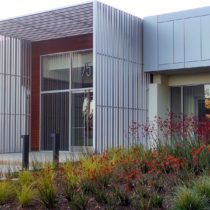Landscape Architecture for Landscape Architects › Forums › SUSTAINABILITY & DESIGN › Sustainable Landscapes Rating System for Sustainable Sites Initiative
- This topic has 1 reply, 9 voices, and was last updated 15 years, 10 months ago by
Brent Jacobsen.
-
AuthorPosts
-
November 5, 2009 at 7:59 pm #172430
 Wes Arola, RLAParticipant
Wes Arola, RLAParticipantHere are the credits or principles that have been established for the Sustainable Landscapes Rating System for Sustainable Sites Initiative
http://www.sustainablesites.org/pilot/
Credit 1.5 Select brownfields or greyfields for redevelopment
Channel development to urban areas to reduce pressure on undeveloped land, reduce resource consumption and restore ecosystem services to damaged sites.Credit 1.6 Select sites within existing communities
Encourage site development within existing communities to reduce pollution and development impacts, support local economy and improve human health.Credit 1.7 Select sites that encourage non-motorized transportation and use of public transit
Encourage site development that is accessible by pedestrians and bicyclists and near public transit to reduce pollution and improve human health.Credit 2.3 Engage users and other stakeholders in site design
Engage with site users and other stakeholders in meaningful participation during the site design process to identify needs and to supplement professional expertise with local knowledge.Credit 3.2 Reduce potable water use for landscape irrigation by 75 percent or more from established baseline
Limit or eliminate the use of potable water, natural surface water (such as lakes, rivers, and streams), and groundwater withdrawls for landscape irrigation. Encourage alternative irrigation methods and water conservation strategies.Credit 3.3 Protect and restore riparian, wetland, and shoreline buffers
Preserve and enhance riparian, wetland, and shoreline buffers to improve flood control and water-quality, stabilize soils, control erosion, and provide wildlife corridors and habitat.Credit 3.4 Rehabilitate lost streams, wetlands, and shorelines
Rehabilitate ecosystem functions and values of any streams, wetlands, or shorelines that have been artificially modified, using stable geomorphological and vegetative methods.Credit 3.5 Manage stormwater on-site
Replicate the hydrologic condition (infiltration, runoff, and evapotranspiration) of the site based on historic, natural, and undeveloped ecosystems in the region.Credit 3.6 Protect and enhance on-site water resources and receiving water quality
Prevent or minimize generation, mobilization, and transport of common stormwater pollutants and watershed-specific pollutants of concern to receiving waters, including surface water and groundwater, and combined sewers or stormwater systems.Credit 3.7 Design rainwater/stormwater features to provide a landscape amenity
Integrate visually and physically accessible rainwater/stormwater features into the site in an aesthetically pleasing way.Credit 3.8 Maintain water features to conserve water and other resources
Design and maintain water features created in the landscape with minimal or no make-up water from potable sources or other natural surface or subsurface water resources.Credit 4.4 Minimize soil disturbance in design and construction
Limit disturbance of healthy soil to protect soil horizons and maintain soil structure, existing hydrology, organic matter and nutrients stored in the soil.Credit 4.5 Preserve all vegetation designated as special status
Identify and preserve all vegetation designated as special status by local, state, or federal entities.Credit 4.6 Preserve or restore appropriate plant biomass on site
Maintain or establish regionally appropriate vegetative biomass to support the ecosystem service benefits provided by vegetation on-site.Credit 4.7 Use native plants
Plant appropriate vegetation that is native to the ecoregion of the site.Credit 4.8 Preserve plant communities native to the ecoregion
Preserve plant communities native to the ecoregion of the site to contribute to regional diversity of flora and provide habitat for native wildlife.Credit 4.9 Restore plant communities native to the ecoregion
Restore appropriate plants and plant communities native to the ecoregion of the site to contribute to regional diversity of flora and provide habitat for native wildlife.Credit 4.10 Use vegetation to minimize building heating requirements
Place vegetation in strategic locations around buildings to reduce energy consumption and costs associated with indoor climate control for heating.Credit 4.11 Use vegetation to minimize building cooling requirements
Place vegetation and/or vegetated structures in strategic locations around buildings to reduce energy consumption and costs associated with indoor climate control.Credit 4.12 Reduce urban heat island effects
Use vegetation and reflective materials to reduce heat islands and minimize effects on microclimate and on human and wildlife habitat.Credit 4.13 Reduce the risk of catastrophic wildfire
Design, build, and maintain sites to manage fuels to reduce the risk of catastrophic wildfire both on-site and in adjacent landscapes.Credit 5.2 Maintain on-site structures, hardscape, and landscape amenities
Maintain existing structures, hardscape, and landscape amenities (e.g., retaining walls and benches in their existing form to extend the life cycle of existing building stock, conserve resources, and reduce waste.Credit 5.3 Design for deconstruction and disassembly
Design to facilitate reuse and avoid sending useful materials to the landfill.Credit 5.4 Reuse salvaged materials and plants
Reuse salvaged materials and appropriate plants to conserve resources and avoid sending useful materials to the landfill.Credit 5.5 Use recycled content materials
Use materials with recycled content to reduce the use of virgin materials and avoid sending useful materials to the landfill.Credit 5.6 Use certified wood
Purchase certified lumber to encourage exemplary forest management that is both environmentally and socially responsible.Credit 5.7 Use regional materials
Reduce energy use for transportation; increase demand for materials, plants, and soils that are extracted, manufactured, or grown within the region to support the use of local resources; and promote a regional identity.Credit 5.8 Use adhesives, sealants, paints, and coatings with reduced VOC emissions
Select paints, sealants, adhesives, coatings, and other products used in site development that contain reduced amounts of volatile organic compounds (VOCs) to reduce harmful health effects associated with air pollution.Credit 5.9 Support sustainable practices in plant production
Purchase plants from providers that reduce resource consumption and waste.Credit 5.10 Support sustainable practices in materials manufacturing
Support sustainable practices in materials manufacturing by purchasing materials from manufacturers whose practices increase energy efficiency, reduce resource consumption and waste, and minimize negative effects on human health and the environment.Credit 6.1 Promote equitable site development
During construction of the site, ensure that the project provides economic or social benefits to the local community.Credit 6.2 Promote equitable use of the site
During site use, ensure that the project provides economic or social benefits to the local community.Credit 6.3 Promote sustainability awareness and education
Interpret on-site features and processes to promote understanding of sustainability in ways that positively influence user behavior on-site and beyond.Credit 6.4 Protect and maintain unique cultural and historical places
Protect and maintain cultural and historical locations, attributes and artifacts to enhance a site’s sense of place and meaning.Credit 6.5 Provide for optimum site accessibility, safety, and wayfinding
Promote site use by increasing user’s ability to understand and safely access outdoor spaces.Credit 6.6 Provide opportunities for outdoor physical activity
Provide on-site opportunities that encourage outdoor physical activity to improve human health.Credit 6.7 Provide views of vegetation and quiet outdoor spaces for mental restoration
Provide visual and physical connections to the outdoors to optimize the mental health benefits of site users.Credit 6.8 Provide outdoor spaces for social interaction
Provide outdoor gathering spaces of various sizes and orientations to accommodate groups, for the purpose of building community and improving social ties.Credit 6.9 Reduce light pollution
Reduce light pollution by minimizing light trespass on-site for the purpose of reducing sky-glow, increasing nighttime visibility and minimizing negative effects on nocturnal environments and human health and functioning.Credit 7.3 Restore soils disturbed by previous development
Restore soil function in areas of previously disturbed topsoils and subsoils to rebuild the site’s ability to support healthy plants, biological communities, water storage and infiltration.Credit 7.4 Divert construction and demolition materials from disposal
Divert construction and demolition (C&D) materials generated by site development from disposal in landfills and combusting in incinerators. Recycle and/or reuse C&D materials on-site, when possible, or redirect these materials back to the manufacturing process, other construction sites, or building materials reuse markets to support a net zero-waste site and minimize down-cycling of materials.Credit 7.5 Reuse or recycle vegetation, rocks, and soil generated during construction
Divert from disposal vegetation, soils, and mineral/rock waste generated during construction to achieve a net zero-waste site.Credit 7.6 Minimize generation of greenhouse gas emissions and exposure to localized air pollutants during construction
Use construction equipment that reduces emissions of localized air pollutants and greenhouse gas emissions.Credit 8.3 Recycle organic matter generated during site operations and maintenance
Design for recycling of vegetation trimmings and, where applicable, food waste to generate compost and mulch to support nutrient cycling, improve soil health, and reduce transportation costs and materials going to landfills.Credit 8.4 Reduce outdoor energy consumption for all landscape and exterior operations
Select energy efficient outdoor fixtures and equipment to reduce energy consumption and costs associated with site use and operations.Credit 8.5 Use renewable sources for landscape electricity needs
Use electicity from renewable sources to reduce the greenhouse gas emissions associated with site operations and minimize air pollution, habitat destruction, and pollution from fossil fuel-based energy production.Credit 8.6 Minimize exposure to Environmental Tobacco Smoke (ETS)
Minimize exposure of site users to Environmental Tobacco Smoke (i.e. secondhand smoke) to improve human health.Credit 8.7 Minimize generation of greenhouse gases and exposure to localized air pollutants during landscape maintenance activities
Reduce, avoid, or eliminate the use of landscape maintenance equipment that exposes site and adjacent building users to localized air pollutants and generates greenhouse gas emissions.Credit 8.8 Reduce emissions and promote the use of fuel efficient vehicles
Promote the use of vehicles that have reduced emissions and/or high fuel-efficiency to reduce pollution and land development impacts from automobile use.Credit 9.1 Monitor performance of sustainable design practices
Monitor and document sustainable design practices to evaluate their performance over time and improve the body of knowledge on long-term sustainability.Credit 9.2 Innovation in site design
To encourage and reward innovative sustainable practices for exceptional performance above requirements and/or innovative performance in sustainable sites categories not specifically addressed by the Sustainable Sites Initiative Guidelines and Performance Benchmarks.November 6, 2009 at 5:11 pm #172439Brent Jacobsen
ParticipantThanks for posting the synopsis of the credits Wes. From everything I have seen and heard about the SSI, it seems like a common sense approach to sustainable design that should provide a good reminder / checklist of the variety of factors to consider in site design. It will be interesting to see how the pilot projects go, though, as the translation and documentation of some of the credits (i.e. social and economic value for surrounding communities) seems to be a practical challenge beyond merely a great design challenge.
November 6, 2009 at 10:09 pm #172438 Geoffrey KatzParticipant
Geoffrey KatzParticipantI concur with Brent. We will all have more comments I am sure as we get to know this system better and better.
November 7, 2009 at 2:41 am #172437 Jason T. RadiceParticipant
Jason T. RadiceParticipantSeems like a rehash of LEED-NC…
November 7, 2009 at 4:05 am #172436 ncaParticipant
ncaParticipantAs I’ve stated before I think SSI will be a good way to make our work more quantifiable which is becoming increasingly important to the viatlity of the profession in this society.
November 9, 2009 at 6:41 pm #172435 Wes Arola, RLAParticipant
Wes Arola, RLAParticipantI feel all these criteria should be applied to any design no matter the intention ( to win a merit or not) It should be our responsibility as designers to address these factors anyways. This system will become a great reminder and a way to assign measurable importance to all factors of projects.
November 20, 2009 at 11:52 pm #172434 Ryan A. WaggonerParticipant
Ryan A. WaggonerParticipantGood point Nick, one that our professor’s kept pushing at school…until our profession holds quantifiable evidence of it’s impact we will have little grounds to prove our worth. I do like having a benchmark to guide those wishing to design sustainably that may not have as much experience in the area. Has anyone heard of potential projects for consideration for SSI?
November 25, 2009 at 10:12 pm #172433 Keven GrahamParticipant
Keven GrahamParticipantKatherine, I heard the meeting was real good and generated a lot of good thoughts. You are right we need the nurseryman on board, we also need the contractors on board and as a complete green industry we need to inform the GC’s so we get and keep sites prepared the correct way. The shift in thinking needs to be happening where landscape is not the last part, the oh we’ll value that in later and the cosmetic fixer for the ills of the site development process. We need to make the site development and landscape architecture a seem less event all the way through. Encourage all in the industry to work toward a common goal of sitting at the table from day one. It can be done and has been done and those projects that have really stand out over the years not just the day we turn it over. SSI gives us a good roadmap to do this and good values to implement. remember it is about ecosystems and apply that where ever you are practicing, it is all related.
January 28, 2010 at 1:32 pm #172432 Jeremy HorwitzParticipant
Jeremy HorwitzParticipant“Credit 1.7 Select sites that encourage non-motorized transportation and use of public transit”
The issue I’d like to bring up in terms of an urban divide is the inequity in facilities and planning for transit and non-motorized transportation such as biking and walking. Cities that embrace biking offer transportation that does not pollute, is low cost and healthy. Many slums do not have transit access, but in many cities it is totally unsafe to bike in any area of the city. Automobiles, affordable to only a few in many places, dominate the setting. In the wealthy city of Copenhagen, thirty percent commute by bike. Bogota has made great strides in providing bike infrastructure. Such investments are relatively low cost compared to infrastructure for automobiles. I think we need to elevate the discussion and need for creating better bike and transport planning in the cities of the world.
__________________
Greentech are specialists in a range of Building Energy Ratings Services.January 28, 2010 at 2:19 pm #172431 Terry MockParticipant
Terry MockParticipantDeepening Perspectives on Sustainable Land Development
http://www.sldi.org/newService/SLDIJan2010.htmlGreen building certification programs today pay scant attention to landscaping, but they should, according to the Sustainable Sites Initiative, which has just announced release of the world’s first rating system for the design, construction and maintenance of sustainable landscapes. This and other certification programs fit well within the scope of holistic sustainable land development principles and Sustainable Land Development International (SLDI) embraces their development. In fact, a SLDI project has applied to participate in the Sustainable Sites Initiative as a portion of its pilot phase participation in The SLDI Code™ best practices system.
Your participation and comments are welcome.
Terry Mock
Executive Director
Sustainable Land Development International – http://www.SLDI.org -
AuthorPosts
- You must be logged in to reply to this topic.


